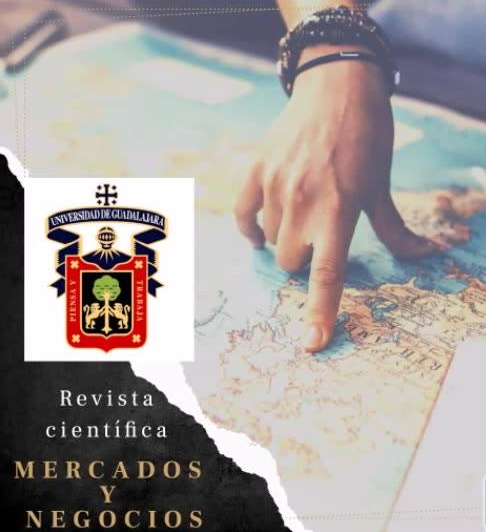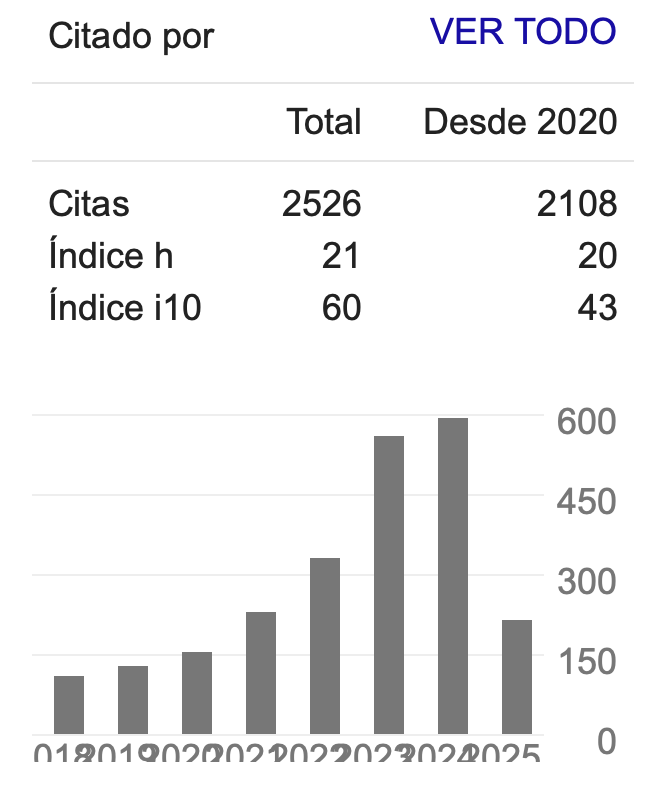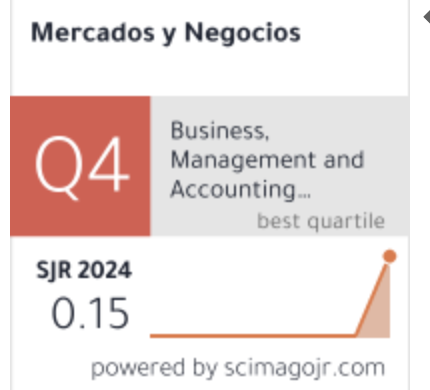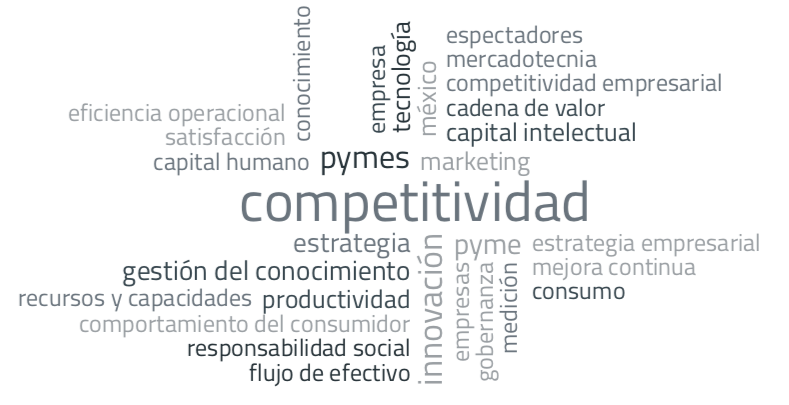Complement and Substitution Effects of Internal Migration on Foundational Competitiveness in Mexico
DOI:
https://doi.org/10.32870/myn.vi54.7769Keywords:
human capital; labor migration; economic developmentAbstract
This study analyzes how internal migration among Mexican states relates to their competitiveness level. The methodology employs longitudinal panel data from 2010 to 2020 to assess how migration influences a state's foundational competitiveness. The study's main results are as follows: First of all, the foundational competitiveness of Mexican states, on average, increased in 2015. However, despite this increase, competitiveness in 2020 was below the 2010 level, showing a general decline experienced in the most recent years of the study sample. Secondly, the econometric results of the present study suggest that greater involvement of a highly educated migrant labor force positively affects foundational competitiveness. Furthermore, findings imply that an influx of working-age migrants may potentially contribute to the economic competitiveness of the destination state depending on differences in education levels of migrants and natives, i.e., whether immigrant human capital complements or substitutes that of the native population.References
Alaimo, L. S., Annoni, P., D’Urso, P., & De Giovanni, L. (2024). Data science for measuring regional competitiveness. Social Indicators Research, 173, 1–7. https://doi.org/10.1007/s11205-024-03347-2
Aldieri, L., Kotsemir, M., & Vinci, C. (2020). The role of labour migration inflows on R&D and innovation activity: evidence from Russian regions. Foresight, 22(4), 437-468. https://doi.org/10.1108/FS-03-2020-0035
Baas, T., & Brücker, H. (2012). The macroeconomic consequences of migration diversion: evidence for Germany and the UK. Structural Change and Economic Dynamics, 23(2), 180-194. https://doi.org/10.1016/j.strueco.2012.01.001
Benitez-Marquez, M., Sanchez-Teba, E., & Coronado-Maldonado, I. (2022). An alternative index to the Global Competitiveness Index. Plos one, 17(3). https://doi.org/10.1371/journal.pone.0265045
Boustan, L., Fishback, P., & Kantor, S. (2010) The effect of internal migration on local labor markets: American cities during the Great Depression. Journal of Labor Economics, 28(4), 719-746. https://doi.org/10.1086/653488
Carpio, L. D., Feldman, P. M., & Avolio, B. (2023). Measuring Regional Competitiveness. Global Business Review. https://doi.org/10.1177/09721509221145445
Casillas, R. (2020). Migración internacional y cambio climático: conexiones y desconexiones entre México y Centroamérica. URVIO Revista Latinoamericana de Estudios de Seguridad, (26), 73-92. https://doi.org/10.17141/urvio.26.2020.4038
Chowdhury, S. (2021). Migration and city competitiveness: a comparative analysis with Surat as a special case. Vision: the Journal of Business Perspective, 25(4), 460-470. https://doi.org/10.1177/0972262919900448
Delgado, M., Ketels, C., Porter, M., & Stern, S. (2012). The determinants of national competitiveness, NBER WP 18249.
Durand, M., Simon, J., & Webb, C. (1992). OECD's Indicators of International Trade and Competitiveness, OECD Economics Department, Working Papers, No. 120, OECD Publishing. https://doi.org/10.1787/708306180711
Ferragina, A., Iandolo, S., & Taymaz, E. (2021). Migration and comparative advantages: new evidence on the EU-MENA region. International Journal of Manpower, 42(5), 904-934. https://doi.org/10.1108/IJM-08-2020-0395
Fratesi, U., & Percoco, M. (2013). Selective migration, regional growth and convergence: evidence from Italy. Regional Studies, 48(10), 1650-1668. https://doi.org/10.1080/00343404.2013.843162
García, Y., & Cuecuecha, A. (2020). El impacto de las remesas internacionales sobre la inversión en educación en la localidad de Caltimacan, Hidalgo. Migraciones Internacionales, 11. https://doi.org/10.33679/rmi.v1i1.1590
García-Sánchez, A., Siles, D., & Vázquez-Méndez, M. de M. (2018). Competitiveness and innovation: effects on prosperity. Anatolia, 30(2), 200-213. https://doi.org/10.1080/13032917.2018.1519179
Gkypali, A., Kounetas, K., & Tsekouras, K. (2019). European countries’ competitiveness and productive performance evolution: unraveling the complexity in a heterogeneity context. Journal of Evolutionary Economics, 29, 665–695. https://doi.org/10.1007/s00191-018-0589-x
Grassia, M. G., Marino, M., Mazza, R. Misuraca, M., Zavarrone, E., & Friel, M. (2024). Regional Competitiveness: A Structural-Based Topic Analysis on Recent Literature. Social Indicators Research, 173, 83–108. https://doi.org/10.1007/s11205-022-02951-4
He, C. (2013). Urbanization and migration. In Ness, I. (Ed.) The Encyclopedia of Global Human Migration. https://doi.org/10.1002/9781444351071.wbeghm568
Holding, B. C., Acciai, C., Schneider, J. W., & Nielsen, M. W. (2024). Quantifying the mover’s advantage: transatlantic migration, employment prestige, and scientific performance. Higher Education, 87, 1749–1767. https://doi.org/10.1007/s10734-023-01089-7
IMCO (2024). Índice de Competitividad Urbana 2024, Instituto Mexicano para la Competitividad. IMCO. Link: https://imco.org.mx/indice-de-competitividad-urbana-2024/
Jiménez-García, C., López-Lira, N., Tomta, D., & Pacheco-Olvera, A. (2011). Competitividad de la economía mexicana, resultados en el periodo 1997-2007. Convergencia, 56, 215-238.
Karman, A., Miszczuk, A., & Bronisz, U. (2023). Discovering the factors driving regional competitiveness in the face of climate change. Miscellanea Geographica – Regional Studies on Development, 27(2), 75-91. https://doi.org/10.2478/mgrsd-2023-0009
Ketels, C. (2017). Cluster mapping as a tool for development, Institute for Strategy and Competitiveness-Harvard Business School: Boston, MA, USA.
Kouskoura, A., Kalliontzi, E., Skalkos, D., & Bakouros, I. (2024). Assessing the Key Factors Measuring Regional Competitiveness. Sustainability, 16, 2574. https://doi.org/10.3390/su16062574
Lamy, B., Ramírez, J., & Sánchez, A. S. (2019). Migración interna y sus efectos en el crecimiento urbano del municipio de Querétaro. Quivera Revista de Estudios Territoriales, 21(2), 49-61. https://doi.org/10.36677/qret.v21i2.12449
Loayza-Alarico, M. (2019). Migración y los efectos en la salud pública. Revista de la Facultad de Medicina Humana, 19(4), 10-11. https://doi.org/10.25176/RFMH.v19i4.2334
Mankiw, N., Romer, D., & Weil, D. (1992). A contribution to the empirics of economic growth. Quarterly Journal of Economics, 107(1), 407-437. https://doi.org/10.2307/2118477
Marti, L., & Puertas, R. (2023). Analysis of European competitiveness based on its innovative capacity and digitalization level. Technology in Society, 72, 102206. https://doi.org/10.1016/j.techsoc.2023.102206
Morrison, A. (2023). Towards an evolutionary economic geography research agenda to study migration and innovation. Cambridge Journal of Regions, Economy and Society, 16(3), 529–542. https://doi.org/10.1093/cjres/rsad013
Navarro, J., & Ayvar, F. (2009). Competitividad, migración y desarrollo rural: una caracterización del caso mexicano. Cimexus, 4(1), 11-27.
Oliinyk, O., Bilan, Y., Mishchuk, H., Akimov, O., & Vasa, L. (2021). The impact of migration of highly skilled workers on the country’s competitiveness and economic growth. Montenegrin Journal of Economics, 17(1), 7-19. https://doi.org/10.14254/1800-5845/2021.17-3.1
Ortega, F. & Peri, G. (2009). The causes and effects of international migrations: evidence from OECD countries 1980-2005, NBER WP 14833.
OECD (2014). How's life in Your Region? Measuring Regional and Local Well-being for Policy Making. Better Life Initiative. Paris: OECD Publishing. https://doi.org/10.1787/9789264217416-en
OECD (2022). Regional economic development: the role of migration. In OECD (Ed.). The contribution of migration to regional development. Paris: OECD Regional Development Studies, OECD Publishing. https://doi.org/10.1787/57046df4-en
Ozgen, C., Nijkamp, P., & Poot, J. (2010). The effect of migration on income growth and convergence: meta-analytic evidence. Regional Science, 89(3), 537-561. https://doi.org/10.1111/j.1435-5957.2010.00313.x
Peri, G. (2012). The effect of immigration on productivity: evidence from US states. The Review of Economics and Statistics, 94(1) 348-358. https://doi.org/10.1162/REST_a_00137
Pinate, A. C., Faggian, A., di Bernardino, C., & Castaldi, C. (2022). The heterogenous relationship between migration and innovation: evidence from Italy. Industry and Innovation, 30(3), 336-360. https://doi.org/10.1080/13662716.2022.2138279
Porter, M. (1990). The competitive advantage for nations, Harvard Business Review, 68(2) 73-91.
Pries, L., Calderón Morillón, O., & Estrada Ceron, B. A. (2024). Trajectories of Forced Migration: Central American Migrants on Their Way Toward the USA. Journal on Migration and Human Security, 12(1), 39-53. https://doi.org/10.1177/23315024231216109
Privara, A., Masarova, T., & Tupa, M. (2023). Migration and labour market competitiveness: the case of EU. Journal of Competitiveness, 15(1), 131-145. https://doi.org/10.7441/joc.2023.01.08
Rajnoha, R., & Lesnikova, P. (2022). Sustainable competitiveness: How does global competitiveness index relate to economic performance accompanied by sustainable development? Journal of Competitiveness, 14(1), 136-154. https://doi.org/10.7441/joc.2022.01.08
Romer, D. (2006). Macroeconomía avanzada, McGraw Hill, 3a. Edición.
Solleiro, J., & Castañón, R. (2012). Competitividad, innovación y transferencia de tecnología en México. Innovación y competitividad, 869, 149-161.
Tacoli, C., McGranahan, G., & Satterthwaite, D. (2014). Urbanization, rural-urban migration and urban poverty. World Migration Report 2015. International Organization for Migration.
Tanrikulu, F. (2020). Impact of international migration on patents, innovation, economy and business strategy. In: Dincer, H., & Yüksel, S. (eds) Strategic outlook for innovative work behaviours. Contributions to Management Science. Springer, Cham. https://doi.org/10.1007/978-3-030-50131-0
Vargas-Hernández, J., & Ramírez, M. (2018). Business Performance, Corporate Structure and Competitiveness in Mexico. In: Dincer, H., Hacioglu, Ü., & Yüksel, S. (eds) Strategic Design and Innovative Thinking in Business Operations. Contributions to Management Science. Springer, Cham. https://doi.org/10.1007/978-3-319-77622-4_2
Vasyltsiv, T., Mulska, O., Levytska, O., Kalyta, O., Kohut, M., & Biletska, I. (2021). External migration and endogenous development nexus: challenges for the sustainable macroeconomic policy. Studies of Applied Economics, 39(8). https://doi.org/10.25115/eea.v39i8.4770
Vîrjan, D., Manole, A. M., Stanef-Puică, M. R., Chenic, A. S., Papuc, C. M., Huru, D., & Bănacu, C. S. (2023). Competitiveness—the engine that boosts economic growth and revives the economy. Frontiers in Environmental Science. 11:1130173. https://doi.org/10.3389/fenvs.2023.1130173
Wassink, J. (2020). International migration experience and entrepreneurship: evidence from Mexico. World Development, 136. https://doi.org/10.1016/j.worlddev.2020.105077
WEF (2001). Global Competitiveness Report 2001. World Economic Forum.
WEF (2014). Global Competitiveness Report 2014-2015. World Economic Forum.
Published
How to Cite
Issue
Section
License
Copyright (c) 2024 Amilcar Orlian Fernández Domínguez, Michael Demmler

This work is licensed under a Creative Commons Attribution-NonCommercial 4.0 International License.
Mercados y Negocios by Department of Mercadotecnia y Negocios Internacionales. University of Guadalajara is licensed under a License Creative Commons Attribution-NonCommercial 4.0 International.
The author retains the copyright.








